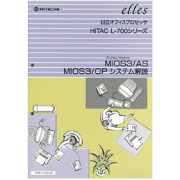- MIOS3
- The MIOS3 series of operating systems began with MIOS3. MIOS3 was developed in 1983 for the HITAC L-30 and 50 series of office computers.
- MIOS3 had the following features.
- (1) Dialog-based processing
- Various processes — including data processing, graph processing, and Japanese document processing — were executed using user-friendly dialogs.
- (2) Interactive Japanese language processing
- Japanese input, using multi-segment kana-kanji conversion, could all be done through dialogs.
- (3) Resource sharing between multiple workstations
- With the L-50 system, up to eight workstations could be connected to the master workstation, and workstations could run multiple processing tasks simultaneously while sharing files on the master workstation. Workstations could also share printers and telecommunication lines connected to the master workstation.
- (4) Connectivity between office computers
- L-30 office computers could be connected as workstations to L-50 or L-70 office computers, and L-50 office computers could be connected as workstations to L-70 office computers. This connectivity permitted flexible upgrades from an L-30 system to an L-50 system and from an L-50 system to an L-70 system as a business grew.
- MIOS3/ES,MIOS/PC
- MIOS3/ES and MIOS/PC were developed in 1986 as operating systems for the HITAC L-30/8 and L-50/8 series of office computers that assisted the integration of office automation functions.
- MIOS3/ES and MIOS/PC had the following features.
- (1) Two operating systems to match different processing characteristics
- Hitachi supplied two operating systems designed to meet different processing characteristics. MIOS3/ES was designed for routine, repetitive processes, while MIOS/PC was designed for non-routine processes and could run the many MS-DOS software titles on the market.
- (2) Construction of large network systems
- These operating systems could be used to construct network systems not only between L series systems but also with M series systems and third-party systems.
- (3) Improved system operability
- System operability was improved in many ways, including supplying messages in Japanese and auto launching dual jobs.
- MIOS3/ES2
- Hitachi developed MIOS3/ES2, which merged the features of MIOS3/ES and MIOS/PC, in 1988 as the operating system for the HITAC L-30/8ES and L-50/8ES series of office computers that assisted more strategic applications of information.
- MIOS3/ES2 had the following features.
- (1) Distributed processing
- HITAC L-30/8ES and L-50/8ES series office computers were capable of distributed and collaborative processing as workstations for the HITAC L-70/8ES series.
- Micro mainframe integration enabled system office automation processing.
See the MIOS7 operating system series page for a description of the concept behind micro mainframe integration. - Joint program development was possible with COBOL, which shared specifications with the L-70/8ES series.
- (2) Data integration
- Micro mainframe integration enabled personal data integration.
- (3) Simultaneous execution of core tasks and office automation tasks
- The operating system improved usability because core tasks and office automation tasks could be run in parallel.
- MIOS3/AS
- Hitachi developed MIOS3/AS in 1989 as the culmination of all prior MIOS3 series operating systems. MIOS3/AS was the operating system for the following office computers.
- HITAC L-710, L-720, and L-730 processor series
- HITAC L-710E, L-720E, and L-730E processor series
- elles 3 series
- With the introduction of MIOS3/AS, the MIOS3 series operating system, in its final incarnation, had the following features.
-
- (1)MIOS3/AS supported a diverse range of business processing tasks because it had two execution modes: the MIOS3/OP mode for routine processes and the MIOS/PC mode for non-routine processes.
- (2)User programs could be made for specific applications, using either record format descriptor (RFD), a simple programming language for creating invoicing tasks or data entry tasks, or COBOL, a programming language for common business processes. See the page on Hitachi’s first-generation operating system for office computers for a description of the concept behind RFD.
- (3)The operating system was designed to simplify operations and standardize program execution and control through cataloged procedures and menu-selection functions.
- (4)Japanese entry function enabled the input of kanji characters.
- (5)The operating system had a dual job function that allowed the simultaneous execution of two jobs.
- (6)MIOS3/AS offered many useful utilities such as a text editor, map definitions, and sort and merge commands.
- (7)The operating system could be used to construct multi-workstation systems.
- (8)The operating system could be used to construct remote-workstation systems.
- (9)The operating system offered a robust set of communication utilities, such as application-to-application communications and file transfers, as well as support for standard protocols, such as the Japan Chain Stores Association’s specified procedures and the Japanese Bankers Association’s personal computer protocol.


